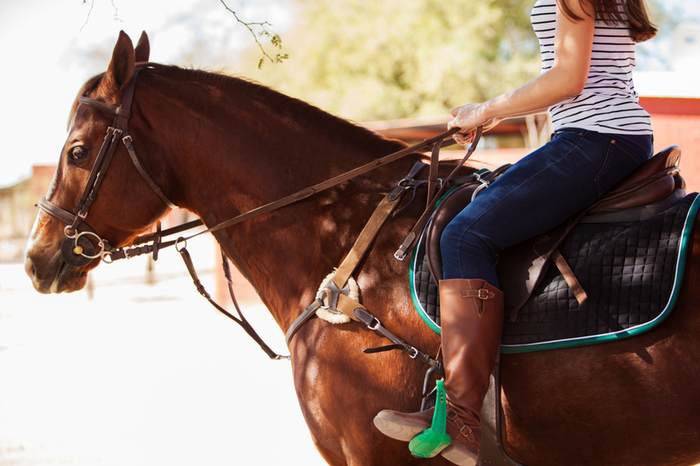- Calls to this hotline are currently being directed to Within Health or Eating Disorder Solutions
- Representatives are standing by 24/7 to help answer your questions
- All calls are confidential and HIPAA compliant
- There is no obligation or cost to call
- Eating Disorder Hope does not receive any commissions or fees dependent upon which provider you select
- Additional treatment providers are located on our directory or samhsa.gov
Treating an Eating Disorder Through Equine Therapy
Eating disorders are serious mental illnesses. Eating disorders are among the deadliest mental illnesses, but they are treatable [1]. Eating disorders are unfortunately common.
In fact, about 9% of Americans are estimated to develop an eating disorder in their lifetime [2].
There are numerous ways to treat eating disorders and each approach offers different benefits. Equine therapy for eating disorders is one treatment modality.
What is Equine Therapy?
Equine therapy is a type of psychotherapy that involves horses [3]. Horses are integrated into the therapy process in order to create behavioral and emotional changes. These changes are meant to lead someone to greater emotional wellness [3].
Eating disorders are a mental illness. At the surface, eating disorders may appear to center around food or body image. However, at the root of an eating disorder, there tends to be unresolved emotions that someone is attempting to cope with through disordered behaviors.
A co-occurring mental illness is when someone has at least two conditions at the same time. Co-occurring mental illnesses are very common in people with eating disorders.
In fact, about 97% of people with eating disorders struggle with at least one other mental illness [1]. Common co-occurring disorders in people with eating disorders include:
- Depression
- Anxiety
- Obsessive-compulsive disorder (OCD)
- Posttraumatic stress disorder (PTSD)
- Alcohol or substance use disorder [1]
Equine therapy can help people work through the psychological symptoms associated with eating disorders and other mental illnesses as well [3].
How Does Equine Therapy Work?
Equine therapy includes a mental health clinician, a horse, and may also include an equine specialist. The human-horse bond is used as a healing mechanism [3]. The relationship between human and horse is what allows equine therapy to be so healing.
Similar to the healing aspect of a relationship between therapist and client, the relationship that participants build with the horse can be deeply healing. The relationship itself paired with the skills learned is used to accomplish treatment goals.
Types of Equine Therapy
There are different types of equine therapy. Not all forms of equine therapy are used for people seeking mental health care. The forms of equine therapy that may be used in eating disorder treatment include [4]:
- Equine-Assisted Therapy (EAT)- This type of therapy includes horses or an equine-related environment in order to provide mental health services. EAT can also be used for physical therapy, occupational therapy, or speech-language pathology.
- Equine-Assisted Learning (EAL)- This approach uses equine-related activities to help people develop life skills.
- Therapeutic Riding- This technique uses horseback riding to accomplish emotional goals.
All these approaches involve horses, but in different ways. Equine therapists can provide individual or group therapy sessions.
What are the Benefits of Equine Therapy in Eating Disorder Recovery
There are other forms of therapy that include animals. However, horses have special qualities that make them especially powerful aides in the healing process. Horses are prey animals, which means they have to pay special close attention to their environment in order to survive [3].
As a result, horses are masters at staying present and responding to non-verbal emotional cues [3]. This essentially makes horses a really clear mirror of people’s emotional states. This provides unique emotional and physical benefits.
Emotional Benefits of Equine Therapy
As mentioned above, horses are constantly analyzing the nonverbal cues, such as body language, in order to appropriately read and react to their environment.
Horses will reflect back to people the emotions they are communicating, whether verbally or non-verbally. This can be helpful for people who struggle to get in touch with their emotions and most authentic self [3].
For people with eating disorders, this can be helpful because there is a tendency with eating disorder patients to struggle to get in touch with their emotions [5]. As the horse reflects the emotions back to you, you have the opportunity to not only get in touch with the feelings but to learn how to regulate them.
Learning to regulate emotions is a core treatment goal in most eating disorder treatment plans. This is because disordered behaviors can be an attempt to deal with negative feelings [4]. Replacing disordered eating with other coping skills is extremely helpful during the treatment process.
Equine therapy can also provide the following emotional benefits [3]:
- Enhanced self-esteem
- Improved ability to trust
- Increased relational skills
- Better quality of relationships
Physical Benefits of Equine Therapy
Traditional therapy does not involve touch. While these industry standards and expectations have been developed as a way to keep therapy safe for consumers of mental health.
However, non-sexual touch is critical for humans [3]. Examples of non-erotic touch include hugging or touching someone’s hand, arm, or upper back [3]. Equine therapy involves frequent touch between the horse and client.
Why is Equine Therapy Effective for Eating Disorder Recovery?
There are certain symptoms or personality traits that are common among people with eating disorders. Recent research shows that it is beneficial for eating disorder treatment to focus on treating personality traits that feed into disordered behavior [5]. These personality traits include [5]:
- Perfectionism
- Impulsivity
- Rigidity, such as being unwilling to try new things or viewing things in terms of good or bad
Equine therapy is shown to be helpful in disrupting these ways of being and helping people create new patterns [3].
Additionally, it is common for people with eating disorders to struggle with fears of abandonment in relationship or finding it difficult to be emotionally close with people [5].
Equine therapy allows for people with eating disorders to work through these issues and develop new relational patterns. Through a relationship with a safe being, such as a horse, people can work through harmful feelings that tend to come up in relationships.
With each new relational experience, someone can integrate this until their new relationship skills become habitual and comfortable [6]. Through the power of relationship and experiential learning, equine therapy offers unique healing potential during the eating disorder recovery process.
Articles on Eating Disorder Treatment Therapies
- Eating Disorder Therapy
- Acceptance Commitment Therapy (ACT)
- Cognitive Behavioral Therapy (CBT)
- Dialectical Behavioral Therapy (DBT)
- Exposure Response Prevention Therapy (ERP)
- Eye Movement Desensitization Reprocessing (EMDR)
- Interpersonal Psychotherapy (IPT)
- Family-Based Therapy
- Maudsley Method
- Medical Nutrition Therapy (MNT)
- Somatic Experiencing
- Art Therapy
- Body Movement Dance Therapy
- Stand Up Paddle Board Yoga
References
[1] National Eating Disorders Association. (n.d). Statistics and Research on Eating Disorders. https://www.nationaleatingdisorders.org/statistics-research-eating-disorders [2] Deloitte Access Economics (2020). The Social and Economic Cost of Eating Disorders in the United States of America: A Report for the Strategic Training Initiative for the Prevention of Eating Disorders and the Academy for Eating Disorders. Retrieved January 2nd, 2022 from https://www.hsph.harvard.edu/striped/report-economic-costs-of-eating-disorders/ [3] Brandt, C. (2013). Equine-assisted psychotherapy as a complementary treatment intervention. The Practitioner Scholar: Journal of Counseling and Professional Psychology, 2, 23-42. [4] Professional Association of Therapeutic Horsemanship International. (n.d). Industry Links. https://www.pathintl.org/resources-education/resources/eaat/193-eas-definitions [5] Fox, J.R.E. (2009). Eating disorders and emotions. Clinical Psychology and Psychotherapy, 16, 237-239. [6] Levallius, J., Clinton, D., Bäckström, M., & Norring, C. (2015). Who do you think you are? Personality in eating disordered patients. Journal of Eating Disorders, 3, 1-8.Author: Samantha Bothwell, LMFT
Page Last Reviewed on February 7, 2022 and Updated By: Jacquelyn Ekern, MS, LPC


